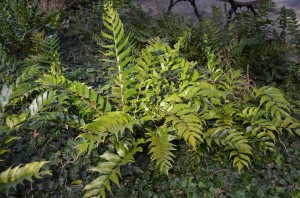Japanese Holly Fern (Cyrtomium falcatum ‘Rochfordianum’) is a handsome, evergreen fern for gardens in USDA hardiness zones 6-11. It earns its name from its stiffly erect holly-like fronds. Individual fronds are vase-shaped, 1 to 2 ½ feet long with glossy, leathery, serrated, holly-like compound leaflets (pinnae). The slender, arching fronds arise from erect, scaly rhizomes just above the soil surface.
Spore masses are light green when young and dark at maturity; they cling to the backs of leafy fronds. Japanese holly fern is evergreen in frost-free growing areas, but tends to lose its fronds in colder climates. It also tolerates more sun than many other woodland ferns.
It is best grown in compost-rich, well-drained soil with medium moisture and in part shade to full shade. Annual mulching around holly fern is beneficial; it does not ask for much feeding. It tolerates dry air, low light and gas fumes in the home better than most ferns. Extreme summer dry spells or too much sun will singe pinnae.
Holly fern develops into an effective groundcover and can be grouped to edge a woodland or shady border. It performs well in containers either planted by itself or mixed with other woodsy perennials. Holly fern also makes a great indoor plant in the colder parts of the U.S. Holly fern is not troubled by disease or pest problems. Problems with root rots or leaf spotting may indicate a poor site. Deer and rabbits usually stay away from the sharp needle foliage.


 Posted in
Posted in 
